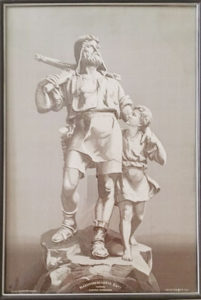 NH sent me a silk textile weaving, generically known today as a Stevengraph. Its history began in the Middle Ages, in a faraway place along the Jona River in a little town then called Ruti. Back then they discovered the Jona river perfect for hydropower and harnessed it to watermills for manufacturing textiles.
NH sent me a silk textile weaving, generically known today as a Stevengraph. Its history began in the Middle Ages, in a faraway place along the Jona River in a little town then called Ruti. Back then they discovered the Jona river perfect for hydropower and harnessed it to watermills for manufacturing textiles.
By 1847 a company called Caspar Honegger established weaving machines on the banks. Later in the 19th century the factory became the Maschinenefabrik Ruti, and NH’s textile hails from this factory.
The theme of NH’s textile also appears medieval Swiss. Yes that IS William Tell with his young son in the picture. The Tell legend dates back upon its earliest telling to 1475. A country scribe referenced Tell as a freedom fighter against Austria (via the ruling family) Hapsburg’s impending domination of the Swiss in 1291.
We all remember the legend
Throughout the life of the William Tell legend, the turbulent 19th century and persisting past WWII, Tell became considered a symbol of rebellion against tyranny. A nasty Hapsburg governor planted his hat on a pole in a Swiss town square and ordered the townspeople to bow before his hat. Tell and his son refused to bow, so the governor ordered the execution of both. The governor proposed withholding the order only if Tell shot an apple off his son’s head with his crossbow. He succeeded. Then he killed the governor.
Talented and varied writers have retold the story:
- the Brothers Grimm (1816),
- Antoine-Marin Lemierre (1766)
- Goethe (1795),
- Rossini (opera 1829)
- Friedrich von Schiller (1804), whose play about William Tell is performed at Interlaken, Switzerland every year since 1947
Now to the Stevengraph Weaving
Done on a silk Jacquard loom, a mechanically operated device to control loops and pulleys, weavers did NH’s textile on the world’s first ‘computer.’ A punch card perforated for every woven line controls each entry of thread of NH’s piece, much like early analogue computer punch cards. An image done with a Jacquard loom as small as a bookmark required 6,000 perforated cards.
In England they call this style of weavings Stevengraph after the inventor Thomas Stevens from Canterbury. Along with Ruti, Switzerland, England became a center of textile manufacturing.
The value of NH’s late 19th century Stevengraph? I found a 20th century copy of this 1860’s image, done by the same Ruti factory, selling for $60. The palette called ‘en griselle,’ is a picture executed in monochrome, or near monochrome, in shades from white to grey to black. They use the technique to imitate classical sculpture, or pen and ink drawings, often executed in copper plate etchings as portrait heads.
NH, hang onto this silk weaving. Today they’re not popular in the antique market, but since they represent the kind of technology that lead to our modern computer, I suspect value will grow.
I have the silk portrait that I think you are referring to. It is mentioned in the Jacquards Collection.http://cdmt.cat/wp-content/uploads/2018/04/publicacions/JacquardsArtistichs_cat%C3%A0leg.pdf